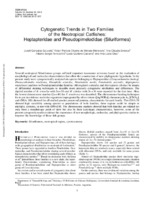Cytogenetic trends in two families of the neotropical catfishes : Heptapteridae and Pseudopimelodidae (siluriformes)

Date
2018-09-05Author
González Gouveia, Juceli
Oliveira de Moraes-Manécolo, Vivian Patrícia
Swarça, Ana Claudia
Fenocchio, Alberto Sergio
Giuliano-Caetano, Lucia
Dias, Ana Lucia
Metadata
Show full item recordAbstract
Several neotropical Siluriformes groups suffered important taxonomic revisions based on the evaluation of morphological and molecular characteristics that allow the construction of new phylogenetic hypothesis. In the present study were cytogenetically analyzed six species belonging to Heptapteridae (Cetopsorhamdia iheringi, Phenacorhamdia tenebrosa, Rhamdella eriarcha, Pimelodella meeki, Pimelodella australis, Heptapterus mustelinus) and two to Pseudopimelodidae families (Microglanis cottoides and Microglanis cibelae) by means of differential staining techniques to describe more precisely cytogenetic similarities and differences. The diploid number of R. eriarcha with 2n = 58 and M. cibelae with 2n = 56 were reported for the first time. Also, the lowest chromosome number (2n = 48) for P. tenebrosa was described. The chromosome-banding techniques for to put in evidence nucleolar organizers impregnated by silver nitrate ([AgNORs], chromomycin A3 [CMA3], and rDNA 18S) showed for all studied species conserved patterns, characteristic for each family. The rDNA 5S showed high variability among species or populations of both families, these regions could be simple or multiple, syntenic, or not with rDNA18S. The chromosome markers showed that both families are related not only from a morphologic point of view but also by their karyotypic characteristics, however, some of the present cytogenetic results evidence the importance of new morphologic, molecular, and phylogenetic studies to improve the knowledge of these fish groups.
Collections
The following license files are associated with this item:



